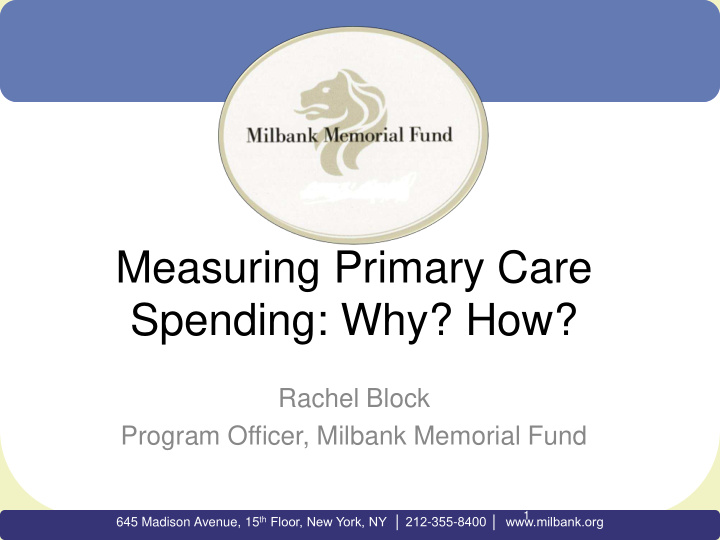



Measuring Primary Care Spending: Why? How? Rachel Block Program Officer, Milbank Memorial Fund 645 Madison Avenue, 15 th Floor, New York, NY │ 212 -355- 8400 │ www.milbank.org 1
Agenda • Background - Milbank Memorial Fund and the evidence base for primary care • Primary care spending measures: – Why measure? – What and how to measure? – Results of the Milbank supported study – Next steps for the Fund – Opportunities 2 │
Milbank Memorial Fund • Mission: Improve the health of populations by connecting leaders and decision makers with the best available evidence and experience (mainly focus on states but interested in alignment and engagement with federal government and private sector as well) • Activities: – Build evidence through research support – Disseminate and use evidence through reports, convening state and other leaders – Examples relating to primary care: • Multi-state collaborative – CPC+ project sites + CMS and their contractors • Primary care and behavioral health integration • Primary care spending measures 3 │
Why? We improve what we measure Can we get a separate slice for primary care? 4 │
How? Milbank study on primary care spending measurement • Published July 2017 • Work conducted under contract with Bailit Health Purchasing and subcontract with Rand • https://www.milbank.org/ publications/standardizin g-measurement- commercial-health-plan- primary-care-spending/ 5 │
Study Purpose and Scope • Purpose: Undertake a proof-of-concept study to determine what percentage of total medical spending high-performing commercial health plans spend on primary care • Scope: A small sample of commercial health insurers from across the U.S. (did not include Medicaid or Medicare) 6 │
Participating plans • High-performing commercial health plans – Bailit Health identified commercial health plans that had NCQA overall ratings of at least 80 and a score of 4 or 5 for prevention and treatment on the 2014 -2015 NCQA plan rankings – Prioritized geographic representativeness among the sampled plans • 29 contacted, 11 agreed to participate, 9 provided usable data 7 │
Methods • Defined “primary care spending” in consultation with other researchers and insurance commissioners • Worked with health plan staff to calculate primary care spending: levels and as % of total health plan spending in 2013 and 2014 – Product (HMO and PPO) – Fee-for-service payments and non-FFS payments (e.g., capitation, bonus, shared savings) – Member demographic and comorbidity groups 8 │
Defining primary care • Measures broken down by specialty, by service codes, and by age groups • Results in a nutshell: – Amounts of primary care spending: less difference by specialty, more difference by service codes – More spending for children, less for older adults │ Slide 9 3/20/2018
Comparing Primary Care $ and %s • FFS payments in dollars – PPO-HMO using broad definition of providers and services = $23-26 pmpm – The range was $14-38 • FFS payments as a percent – PPO-HMO = 6.7-7.4% – The range was 3.4-12.5% │ Slide 10 3/20/2018
Primary care spending, by age group Per-member per-month primary care spending, ALL services, FFS + other, 2014 HMO This is primary care definition 1: Age group PCP-D $ PCP-D % Provider -based ≤18 $34 (28-50) 18% (14-21) 19-24 $18 (10-26) 9% (4-13) 25-34 $23 (9-40) 8% (3-13) 35-44 $25 (12-43) 7% (3-11) 45-54 $30 (16-64) 7% (3-14) 55-64 $34 (20-62) 6% (3-13) Findings were similar for all PCP and payment types │ 11
Limitations • Small number of high-performing plans • Self generated, voluntary, unaudited numbers from insurers – Plans particularly challenged by request to provide non-FFS spending figures • Regardless of definition, started with insurers’ designation of PCP label 12 │
Next steps for Milbank 1. Work with states to replicate measures, legislation and regulation (building on RI and OR examples) 2. Disseminate these results - professional meetings, articles 3. Broader Discussions: – Collaborate with specialty societies and researchers on refining definitions – Sponsor additional research using measures to establish Medicare spending levels – Connect with others developing and using measures (e.g., HCCI report includes primary care spending measure) – AND continue to support multi-payer models for PC support 13 │
Opportunities for state consideration • State-level – Legislation – Regulation – Alignment with other measures used for statewide initiatives (ACO measures, TCC measures) • Region-level – Generate PC spend measures using local data – Monitor PC spend in conjunction with local APM and ACO activities 14 │
Conclusions • Policy and evidence suggests it is important to measure primary care investment • Research and state efforts suggest it is feasible to develop and use primary care spending measures • Administrative issues: – Resources are required, need to plan for it – insurer side, state/convener side – Transparent process and trust in data • Policy Issues: – ”Build to purpose” – what is the desired unit of analysis, level of detail or precision needed – Standardizing measures will facilitate valid comparisons – Need to establish or validate relationship of primary care spend to total cost measures – Evaluate impact of all payer model and VBP on primary care “sensitive” performance measures │ Slide 15 3/20/2018
Primary Care Transformation: The Big Picture (CPC+ Model Components) │ Slide 16 3/20/2018
Questions? • If you’d like additional information about Milbank activities: – PC spending, total cost of care measures • rblock@milbank.org – Multi-state collaborative – national forum for CPC+ projects • lwatkins@milbank.org 17 │
References • Commonwealth Fund health system performance commentary http://www.nejm.org/doi/full/10.1056/NEJMp1708704 • Milbank perspectives article on primary care spending rates http://www.nejm.org/doi/full/10.1056/NEJMp1709538?query=featured_home & • Oregon legislation: requiring primary care spending report https://olis.leg.state.or.us/liz/2015R1/Downloads/MeasureDocument/SB231/ Enrolled • Oregon legislation: setting standards for primary care spending levels https://olis.leg.state.or.us/liz/2017R1/Downloads/MeasureDocument/SB934/ Enrolled • Oregon primary care spending report http://www.oregon.gov/oha/HPA/CSI- PCPCH/Documents/2017%20SB231_Primary-Care-Spending-in-Oregon- Report-to-the-Legislature.pdf • Rhode Island insurance standards http://www.ohic.ri.gov/documents/2017- 2018-Care-Transformation-Plan-Final-Adopted%20-2017-1-27-w- Attachment-A.pdf │ Slide 18 3/20/2018
Recommend
More recommend